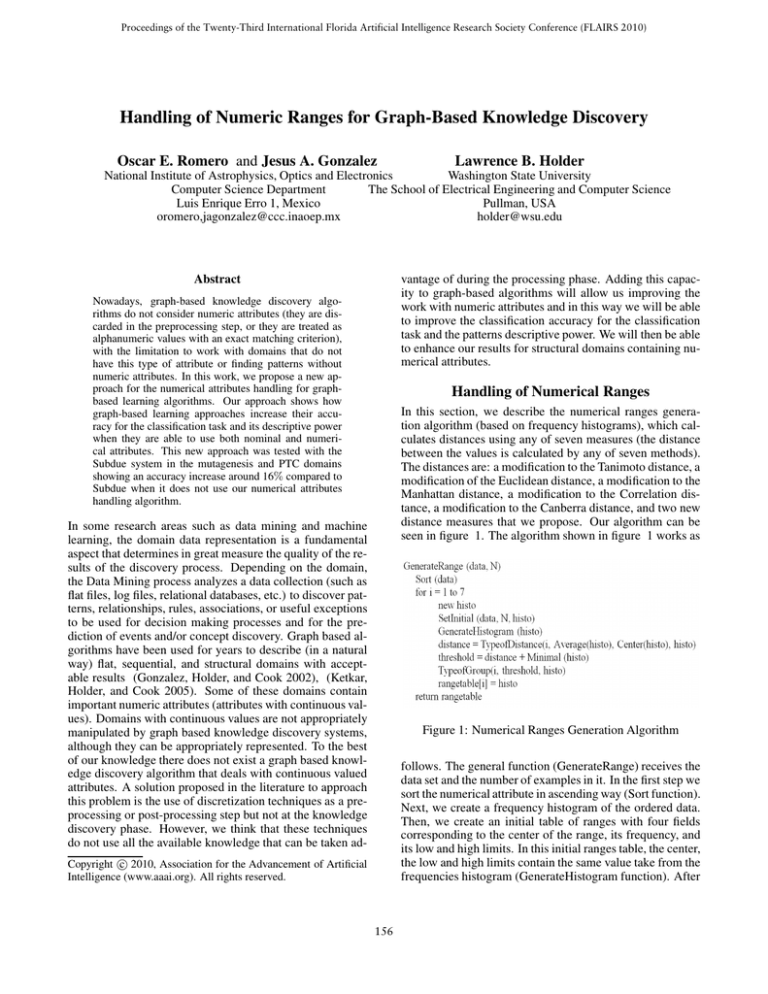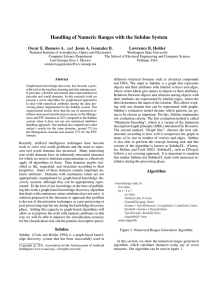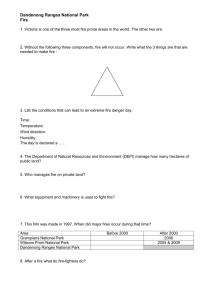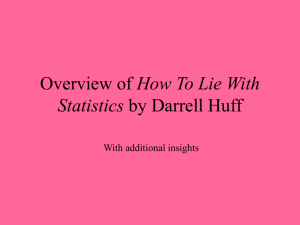
Proceedings of the Twenty-Third International Florida Artificial Intelligence Research Society Conference (FLAIRS 2010)
Handling of Numeric Ranges for Graph-Based Knowledge Discovery
Oscar E. Romero and Jesus A. Gonzalez
Lawrence B. Holder
National Institute of Astrophysics, Optics and Electronics
Washington State University
Computer Science Department
The School of Electrical Engineering and Computer Science
Luis Enrique Erro 1, Mexico
Pullman, USA
oromero,jagonzalez@ccc.inaoep.mx
holder@wsu.edu
vantage of during the processing phase. Adding this capacity to graph-based algorithms will allow us improving the
work with numeric attributes and in this way we will be able
to improve the classification accuracy for the classification
task and the patterns descriptive power. We will then be able
to enhance our results for structural domains containing numerical attributes.
Abstract
Nowadays, graph-based knowledge discovery algorithms do not consider numeric attributes (they are discarded in the preprocessing step, or they are treated as
alphanumeric values with an exact matching criterion),
with the limitation to work with domains that do not
have this type of attribute or finding patterns without
numeric attributes. In this work, we propose a new approach for the numerical attributes handling for graphbased learning algorithms. Our approach shows how
graph-based learning approaches increase their accuracy for the classification task and its descriptive power
when they are able to use both nominal and numerical attributes. This new approach was tested with the
Subdue system in the mutagenesis and PTC domains
showing an accuracy increase around 16% compared to
Subdue when it does not use our numerical attributes
handling algorithm.
Handling of Numerical Ranges
In this section, we describe the numerical ranges generation algorithm (based on frequency histograms), which calculates distances using any of seven measures (the distance
between the values is calculated by any of seven methods).
The distances are: a modification to the Tanimoto distance, a
modification of the Euclidean distance, a modification to the
Manhattan distance, a modification to the Correlation distance, a modification to the Canberra distance, and two new
distance measures that we propose. Our algorithm can be
seen in figure 1. The algorithm shown in figure 1 works as
In some research areas such as data mining and machine
learning, the domain data representation is a fundamental
aspect that determines in great measure the quality of the results of the discovery process. Depending on the domain,
the Data Mining process analyzes a data collection (such as
flat files, log files, relational databases, etc.) to discover patterns, relationships, rules, associations, or useful exceptions
to be used for decision making processes and for the prediction of events and/or concept discovery. Graph based algorithms have been used for years to describe (in a natural
way) flat, sequential, and structural domains with acceptable results (Gonzalez, Holder, and Cook 2002), (Ketkar,
Holder, and Cook 2005). Some of these domains contain
important numeric attributes (attributes with continuous values). Domains with continuous values are not appropriately
manipulated by graph based knowledge discovery systems,
although they can be appropriately represented. To the best
of our knowledge there does not exist a graph based knowledge discovery algorithm that deals with continuous valued
attributes. A solution proposed in the literature to approach
this problem is the use of discretization techniques as a preprocessing or post-processing step but not at the knowledge
discovery phase. However, we think that these techniques
do not use all the available knowledge that can be taken ad-
Figure 1: Numerical Ranges Generation Algorithm
follows. The general function (GenerateRange) receives the
data set and the number of examples in it. In the first step we
sort the numerical attribute in ascending way (Sort function).
Next, we create a frequency histogram of the ordered data.
Then, we create an initial table of ranges with four fields
corresponding to the center of the range, its frequency, and
its low and high limits. In this initial ranges table, the center,
the low and high limits contain the same value take from the
frequencies histogram (GenerateHistogram function). After
c 2010, Association for the Advancement of Artificial
Copyright Intelligence (www.aaai.org). All rights reserved.
156
that, we calculate the minimum distance between any two
consecutive row, using their center fields (Minimal function), and we calculate an average of all the center fields
of the frequency histogram (Average function). After that,
we calculate the centroid for the center fields of the table of
ranges, which corresponds to the element of the frequency
histogram closest to the value of the average (Center function). We now calculate a type of distance that is used to
calculate the grouping threshold (to decide which values are
grouped to create a numerical range). In the next step we
calculate a grouping threshold, which is the sum of the minimum distance plus the distance. After that, we iteratively
group the elements of the ranges table until the table of
ranges does not suffer any modification (TypeofGroup function). At this step we have obtained a final table of ranges.
handle numerical ranges makes it able to find better models. Table 2 shows the results obtained with Subdue (with
Type of Graph-Based
Data Representation
Without Ranges
Without Rings
With Ranges
Without Ranges
With Rings
With Ranges
PTC
FM
MR
62%
54%
70%
62%
65%
57%
74%
76%
FR
58%
66%
61%
80%
Table 2: Accuracy achieved for the PTC database using a
3-fold-cross-validation.
and without ranges) for the PTC database. In this table it
is possible to observe that, on average, the classification accuracy increased 11% when we use our proposed method to
handle numerical ranges for both data representations (with
and without rings). This accuracy increment is not as high
as we expected it to be, but as in the previous table, it is due
to the execution of Subdue with limited parameters. We can
also see in the table that the classification accuracy for all the
subsets of both databases (PTC and Mutagenesis databases)
is stable, which differs from the results reported in related
works.
Results
In this work we experimented with different data representations of numerical ranges for two structural databases. These
databases are: Mutagenesis and PTC (The Predictive Toxicology Challenge for 2000-2001). Both databases were created by the National Institute of Environmental Health Sciences (NIEHS). In order to show how Subdue can be enhanced when adding the capability to deal with numeric attributes, we performed our first experiment, in which we did
not give any special treatment to each numerical attribute.
With our second test we show that Subdue is able to find
interesting patterns containing numerical values when we
generated numerical ranges (also improving its classification
accuracy). We included our numerical ranges information to
our graph-based representations and executed a 3-fold crossvalidation with Subdue. We can see the results for the mutagenesis database in table 1 and for the PTC database in table
2. Table 1 shows the results obtained for the mutagenesis
Type of Graph-Based
Data Representation
Without Ranges
Without Rings
With Ranges
Without Ranges
With Rings
With Ranges
MM
66%
74%
69%
78%
Conclusion and Future Work
The main contribution of this work considers a guideline for
the creation of a graph-based representation for mixed data
types (continuous and nominal) and also the creation of an
algorithm for the manipulation of these graphs with numerical ranges for the data mining task (classification and discovery). For our future work we will test different domains
to enrich the results of our approach. We will also include
temporal information with numerical values. After we have
collected this data, we will be able to perform a spatial and
temporal data mining process. Finally we will compare our
results with Subdue against other algorithms that can deal
with structural representations such as inductive logic programming systems.
Regression
Unfriendly
Friendly
58.54%
69.39%
82.85%
89.00%
61.54%
72.13%
84.36%
90.80%
Acknowledgements
The first author acknowledges Conacyt for the support provided in my doctoral studies with the scholarship number
86997.
Table 1: Accuracy achieved for the Mutagenesis database
using a 3-fold-cross-validation.
database with and without the use of numerical ranges for
both data representations (with and without rings). The behavior of the results for both representations is stable. We
think that by adding rings to representation “I” to create
representation “II” we obtained better accuracy results and
more descriptive models (with structural information about
rings). The input graph of representation “II” is larger than
the one created for representation “I”. This means that the
search space for representation “II” is larger than the one
for representation “I” and we need to increase Subdue’s parameters in order to find a better model in terms of classification accuracy. However, we obtain a 21% increment
when using numerical attributes with both data representations, which means that providing Subdue the capability to
References
Gonzalez, J. A.; Holder, L. B.; and Cook, D. J. 2002.
Experimental comparison of graph-based relational concept
learning with inductive logic programming systems. In Lecture Notes in Artificial Intelligence, volume 2583, 84–99.
Springer Verlag.
Ketkar, N. S.; Holder, L. B.; and Cook, D. J. 2005. Comparison of graph-based and logic-based multi-relational data
mining. SIGKDD Explor. Newsl. 7(2):64–71.
157



